Ironically, house prices dropped the most in Silicon Valley.
In the nine-county San Francisco Bay Area, house prices – as measured by the median price where half of the houses sold for more and half sold for less – dropped 5.4% in September compared to September last year, to $880,000, according to the final data by the California Association of Realtors (C.A.R.) released today. It was the eighth month in a row of year-over-year declines. The median price in September was down 16.2% from the peak in May 2018 and has now fallen below April 2017.
The 12-month moving average (red line in the chart below), by definition, lags behind but shows longer-term trends more clearly. After double-digit year-over-year gains in 2018, the 12-month moving average began to taper in early 2019, approached zero growth in June and July, turned negative on a year-over-year basis in August (-0.8%) for the first time since July 2012 when the Bay Area was emerging from Housing Bust 1, and fell 2.3% in September compared to September last year:
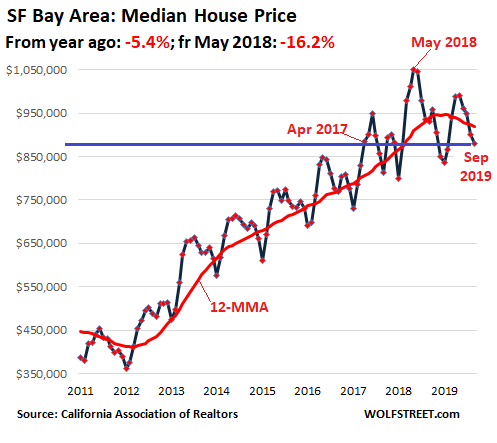
In California overall, the market has split: Single family house prices are still rising: The median price at $605,680 in September, was up 4.7% from September last year; but condo prices have been falling for months, with the median price down 2.1% year-over-year.
But the state-wide median prices were dragged down by the San Francisco Bay Area. In all other major regions, median prices of single-family houses (SFH) and condos rose in September compared to a year ago. The Bay Area sticks out like sore thumb:
- Los Angeles metro: SFH +4.8% ($545,000). Condo +2.1% ($438,000)
- Central Coast: SFH +2.4% ($695,000). Condo +5.4% ($575,000)
- Central Valley: SFH +4.7% ($340,250). Condo +11.1% ($220,000)
- Inland Empire: SFH +4.6% ($385,000). Condo +5.9% ($303,000)
- SF Bay Area: SFH -5.4% ($880,000). Condo -1.9% ($705,000)
So here we go county by county for the San Francisco Bay Area.
The Bay Area is vast: Nine counties spread around a series of bays, of which the “San Francisco Bay” is only one. There are only a handful of bridges across the bays. In addition, there are mountains. “Commutes can be hellish” is an understatement. The more arduous the commute to San Francisco and Silicon Valley, the less ludicrously expensive the housing market.
In San Mateo County, the northern part of Silicon Valley, the median house price in September fell 8.1% year-over-year, to $1.47 million. This is down 16.9% from the peak in April 2018 and just below where it had first been in April 2017.
The 12-month moving average (12-MMA) of the median house price fell in September on a year-over-year basis for the first time since June 2012, after double-digit year-over-year gains through November last year:
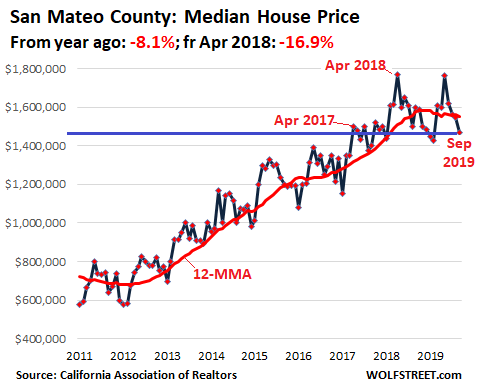
In Santa Clara County, the southern part of Silicon Valley and the most populous county in the Bay Area, the median house price dropped 2.0% year-over-year, to $1.22 million, which is down 15.8% from the peak in April 2018 and just below where it had first been in October 2017.
The 12-MMA dropped 5.6% year-over-year, the fifth month in a row of ever larger year-over-year declines. The county includes San Jose, and ranges from Palo Alto in the north to Gilroy in the south. In mid-2018, the 12-MMA had still surged at rates of over 20%:
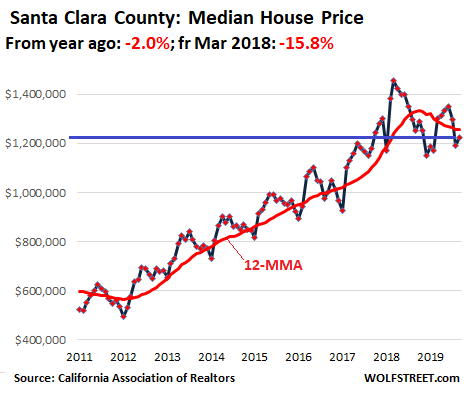
In San Francisco, the median house price has been extremely volatile over the past two years, even by San Francisco standards, dropping in January to $1.376 million and then spiking 28% in six months to $1.76 million in June. And now it’s in the process of giving up those gains again. In September, the median house price fell to $1.54 million, down 12.6% from June, but still up 2.2% from a year ago, though it’s below where it had been in October two years ago. So yes, whiplash. The 12-MMA dipped into the negative for the first time since June 2012:
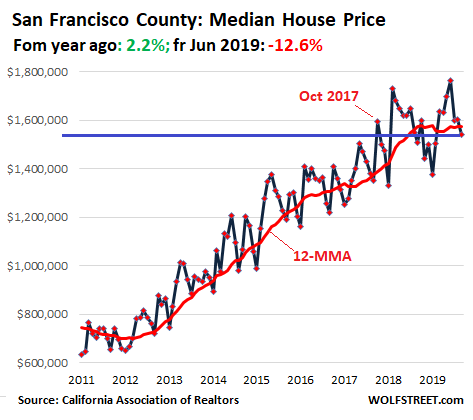
The thing is, house prices were supposed to explode in Silicon Valley and San Francisco, ignited by the lowest mortgage rates in about three years and by the hordes of IPO millionaires from Uber, Lyft, and all the other companies that would all of a sudden get house-hunting fever, though they’ve been millionaires for years, and had access to this money long before the IPO. This time-honored real-estate hype about IPO millionaires was proven wrong during the last two tech-bubble peaks. Those episodes were both followed by housing busts. And a similar scenario is starting to build up on the horizon.
In Contra Costa County, the median house price ticked up 0.9% in September compared to a year ago, to $656,000 but was down 6.6% from the peak in June 2018 and is now back where it had first been in May 2017. The 12-MMA has been flat for eight months in a row:
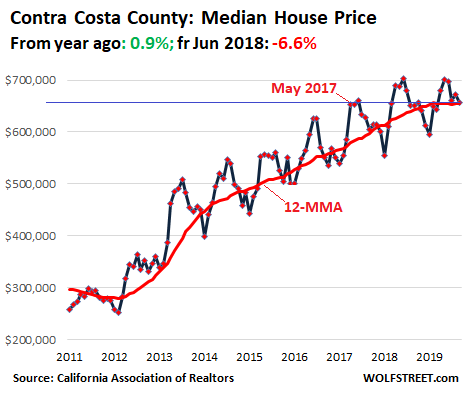
In Alameda County, where Oakland and Berkeley are, the median house price has also been exceptionally volatile over the past two years. In September, it was up 1.1% from a year ago, but was down 11.2% from the peak in May 2018 and is back where it had first been in June 2017. The 12-MMA fell for the third month in a row (-1.8%), something not seen since mid-2012:
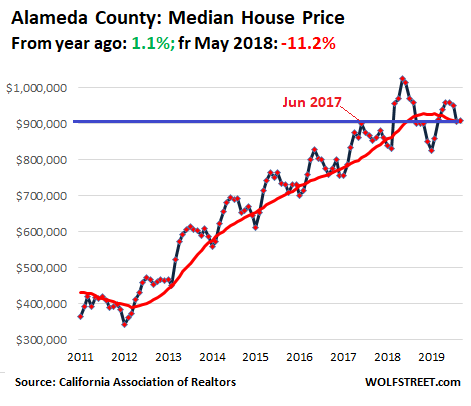
In Sonoma County, which forms part of Wine Country, something funny happened in August: The median price suddenly spiked out of nowhere, and folks thought the boom was back, but in September that spike collapsed back into nowhere. This left the median price flat year-over-year and down 7.0% from the peak in June 2018 and back where it had first been in November 2017. The 12-MMA fell 3.3% from a year ago, its sixth month in a row of year-over-year declines:
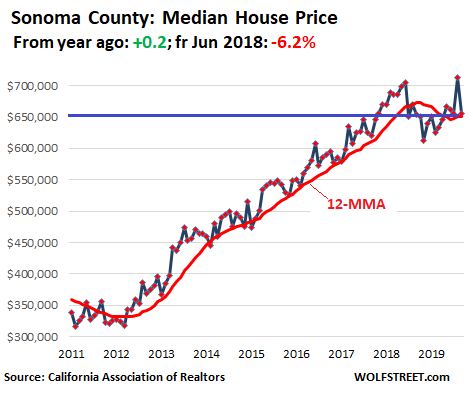
In Napa County, the median house price in September did what it had done in Sonoma County in August: It spiked hugely, up 12.6% in just one month, which left it up 14.9% from a year ago, and it will certainly get unwound over the next few months:
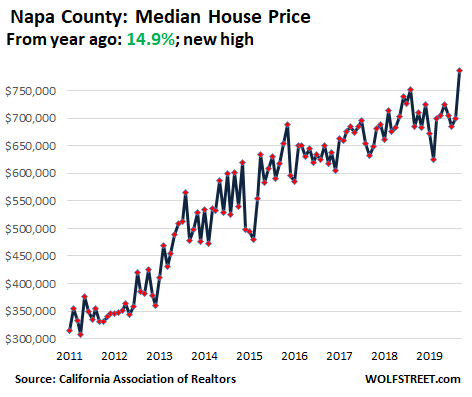
Marin County, connected to San Francisco via the Golden Gate Bridge and ferry service, is among the most expensive places in the Bay Area. It has not been spared the house price declines. The median house price fell 2.5% in September from a year ago, to $1.36 million and is down 6.2% from the peak in October 2018:
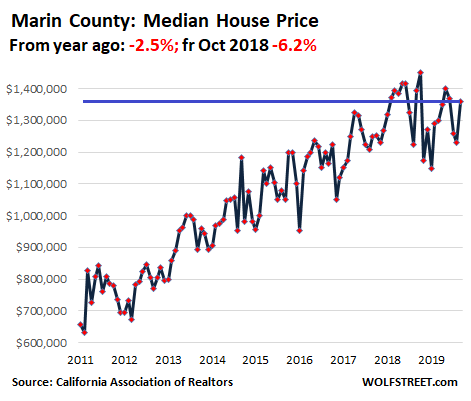
Solano County, extending east and north from the city of Vallejo – which filed for bankruptcy in 2008 – is the least expensive county in the Bay Area. The median home price at $455,000, is about flat with May 2018 and is up only about 1.5% since July 2017, despite the dip and rise in between:

Enjoy reading WOLF STREET and want to support it? You can donate. I appreciate it immensely. Click on the mug to find out how:
![]()


It is great to see county-by-county median data, but cannot help but think that some of the crazy price spikes like in Napa was due to some unusual quantity of high-end properties being sold (weary owners wanting to get out before the next fore, perhaps)
I really wish the Case-Shiller index would have a county-by-county breakdown for the SF Bay Area. Not a complaint, awesome work by Wolf.
I’m sure that’s part of it Maybe less foreigners as well The smart money is selling for sure just like in 2006
In 2006 it seems the avg. house here was losing $50k a year. It was a long slow downward grind, until mid-2007 when the bubble really popped.
Interesting about the condo v. SFR prices, in my past life as an appraiser falling condo prices were the canary in the coalmine- the weakest link breaking first and winnowing the pool of move up buyers, ultimately showing up in SFR figures. Also rising HOA fees adversely affect value, as my late mother learned the hard way.
Indeed regarding rising HOAs My late mother also had that problem but at least she could afford it and not have to worry about maintaining a single family home As these mostly poorly constructed condos age the cost to maintain them goes through the roof I noticed that when looking at nice older townhomes in Raleigh One that I really liked and was priced well had outrageous HOAs so I balked on it
Condos are generally the last to appreciate and the first to fall.
I see condos as the buy-here-pay-here cars of the housing industry. There are people who need them, and they’re often a first step in house (or car) ownership, but then it’s move up or walk away.
Predictions are finally coming to fruition. It only took us 8 years to get here. Let’s see how long it lasts
There have been a number of stories about wine country prices being impacted by the 2-year anniversary of the fires, with a significant number of people who lost homes finally giving up on rebuilding and just buying when the standard two years of insurance payments for rent end in October.
Not confirmation, but anecdata:
Friend of ours is in Sonoma now helping her lifelong friend clear out and prep for sale her dream home/estate due to intense fear of future fires. They’ve been living the dream there for decades and now dream = nightmare to them…
Keith Jurow said to Real Vision Finance essentially that billions in real estate remain in default since 2008 but were not foreclosed upon, because that would have depressed (really collapsed) the prices in the housing market. https://www.youtube.com/watch?v=GFkkN2M3Y3c. I had heard words to that effect but dismissed the statement, because it was so unbelievable.
Banks’ actual, realizable capital is like an onion skin covering their liabilities: e.g., sums owed to depositors (bank deposits) and expected losses on $200 trillion in essentially gambling bets on derivatives. If that is the case, the only thing that is keeping the banks from needing another trillion dollar bailout (giving more free money to the banksters) is the ignorant housing market: e.g., stupid investors trading in the real estate market (and homeowners) still thinking that home prices really will go up.
The banksters sold securitized mortgages (secured by mortgages on homes that the purchasers could not afford to repay, which only the banksters were in a position to know) to gullible investors, which their cronies in credit rating agencies had rated AAA. Then, they bet that the mortgages would not be repaid. In short, not satisfied with just ripping off pension funds and gullible investors, the banksters decided to profit from betting that the gullible investors, whom they had defrauded, would lose their investments, which they knew were the financial equivalent of “toxic waste”! See https://www.mcclatchydc.com/news/politics-government/article24561376.html, which is the article entitled “How Goldman secretly bet on the U.S. housing crash”
When a recession hits and real estate prices go back down, the banks are thereby toast. The banks will come back and demand another trillion dollar bail out, by panicking the US congress (with the understandable, sudden declines in the stock market, because the banks’ stocks will be recognized as worthless by investors) with the connivance of bankster treasury secretaries and corrupt politicians. As a condition to any other help, we should require that ALL such banks’ stocks be turned over to the tax payers (since the stocks of insolvent banks would be worth zero) and put into the social security administration, so taxpayers can profit from the banksters’ shenanigans.
The banksters (the control groups of the banks) have made huge profits since 2008 paid to them in dividends and by price increases (from innocent investors) on stock, which they sold. If Mr. Keith Jurow is correct, the banks may have been technically insolvent. The government should recover such transfers to the bankster control groups from such insolvent banks, because legally they are fraudulent transfers.
At a minimum, the tax payers should receive all future bank profits instead of those banksters. Moreover, if the banksters knew about all of these problems (and of course they would) Rule 10b(5) can be used to prosecute them. 17 CFR § 240.10b-5 – Employment of manipulative and deceptive devices.
If we get an honest government next year (one can dream), perhaps they will be prosecuted and sued to recover their fraudulently obtained profits. I opine that is why the Republicans are terrified of Elizabeth Warren, because she appears to be honest, willing to fight them, and knowledgeable about their frauds.
In the previous election, the big money heavily favored Hillary over Trump.
If we get a real trust-buster in the Democratic primaries we could see the big money rushing to back Trump against it. The irony would be quite enjoyable for me.
I think this next election may be the first in a my voting span where I could be happy with either result.
This is GREAT NEWS for socaljim. Expect another leg up, prices to double in 5 years.
Buy now or be priced out forever!
I hope that’s sarcasm Buy gold and buy property after the bubble pops completely with the profits from the gold IMO
Indeed it is. I’ve been calling the real dollar top for RE since last year. When a 100bp cut in mortgage rates makes it go sideways, this market is cooked.
Sadly, Jim no longer posts here with his twisted pretzel logic about how it’s a rocket ship to the moon.
Hard to imagine why, with a lovely anklebiter like you pointlessly bringing him up any time Wolf posts something on RE.
The best part is that you don’t even realize that you are the flip side of the Socaljim coin, so attached to your notion that market crash lightning is going to strike twice in the same location.
Ok, but it’s like the 8th “bust” in 5 years.
xear,
No. It’s the first bust since the last one that ended in early 2012. In between was the boom — a HUGE boom.
Relax, sit down and grab some popcorn. This is just the first innings of bubble bust 2.0. Wait till Pooh bear Xi demands the laundered money back….that’s when the executions start
crushing.housing.losses.
How dare you insult Chairman Pooh!
It’s interesting how there are still so many local markets in US. I have been researching beach property in southern N. Carolina. It’s a vacation home market.
You could basically buy a home in 2016 for same price as in 2006. Home prices have increased in the last 3 years and seem to have really escalated in the last year.
Unless sales *volume* data is also included, pricing data can be seriously misleading – usually on the pro bubble side.
It is the same problem as with market cap – the marginal moron/manipulator gets his valuation opinion inappropriately scaled up.
One buyer at a bazillion dollars, does *not* make everyone’s home worth a bazillion – there are not enough bazillion sure buyers out there.
Ditto for median sales prices in a month with three sales…
Not in all Eastern NC markets There are some areas that are still stuck at 2008 prices and dropping Depends on the demographics interested in buying in the particular town Oceanfront areas may be better as out of Towners with deep pockets are buying
Gorgeous rural Florida typical acre+ with a family home in the very low Hundred thousands. Natural paradise.
The higher-end SC beach communities (Kiawah, Isle of Palms) are not doing very well. Prices way too high for even well-off normal people to buy. But the wild card will be the changes to the NFIP rates starting in 2020.
An economy based selling ever increasing housing shacks to each other and working for “high tech” firms that will never make a profit.
How do you think it will end?
Slowly at first…then all at once.
I understand the Fed wanting to do everything possible to try to keep the expansion going, but it’s pretty clear damage is being done. Most of Americans don’t have the time to be financial experts. What are the lessons the Fed has tried to teach the last 10 years?
1) You are stupid to hold cash
2. You are stupid if you don’t leverage up on real estate
3. You are stupid if you don’t own stocks and long term bonds
4. You are stupid if you don’t buy tech stocks and dump value stocks
5. You are stupid to not go out on the risk curve with bonds
6. You are stupid if you don’t index
Treasury makes a lot more net new money in Notes then Bonds rather than T bills. While they issue a lot of Bills, most of the Bills are used to pay maturing Bills. So it’s like a big fast rat wheel.
So anything that kicks the can down the road several years (average about 69 months) is their strategy. That’s longer than one term in office.
Reserves is the new cash.
And that will all be turned on it’s head shortly just like in 2008 due to the unsustainable debt levels worldwide Got Gold?
@Oldschool
You’re stupid until you’re not… Reminds me a awful lot of 2007. A bunch of cocksure clowns out there talking about getting rich off of the “wall of worry”.
Fast forward a few months and they were all crying like Jim Crammer. I don’t wish for economic calamities but I sure would enjoy seeing Cramer have another melt down before I die.
I wouldn’t mind seeing that before I die as well
> Jim Crammer.
I like your spelling. :)
> I sure would enjoy seeing Cramer have another melt down before I die.
You have no idea how bad it is out there. NO IDEA! YOU KNOW NOTHING!
7. It is courageous to spend all of your income, plus the income you haven’t earned yet.
Oh 2banana you’re so full of it … everyone knows we can all get rich by delivering each other pizzas. Really, who doesn’t like pizza? And everyone’s got to eat!
Spikes in Sonoma and Napa counties probably due in part to the insurance money (rent allowance) running out, so those whose house burned down finally had to buy. Some tech money getting out at the peak and retiring in wine country also in the mix. It sure wasn’t due to an explosion in new business and net in-migration. The north bay has some interesting dynamics.
Exactly. Buy 10-30 acres of vineyard – but it’s a “home.”
What’s wrong with 10-30 acres of vinyard? Park an RV on it and it’d be fine with me. Grow grapes, harvest some wild turkey on the hush-hush, have a garden, what’s not to like?
I have noticed in the Midwest a lot of Vinyards popping up. 30 acres at $3000 per acre plus and RV would set you back just over $100k.
Is the wine that much better in Cali?
Those two factors sound entirely plausible to me. Indeed, probably not a real boom in Napa of any sort.
I was living in San Rafael in 1989 when the Loma Prieta earthquake hit. We were a long way (75-80 miies) from the epicenter so there wasn’t a lot of damage but the shaking was severe. A line Yamaha motorcycles out front of the dealers store fell over like a row of dominoes. Few people have earthquake insurance ( its expensive and deductibles are high) but the ‘scientists’ say the Hayward fault ( quiet since 1860) has a 50% or greater chance of generating a 7+ earthquake in the next 30 years. San Andreas can deliver an even bigger one.
I live on Sarasota Bay today and I’m on the waters edge if 4 floors up. Still you have to have flood insurance if you live in a flood zone. Thing is a hurricane storm surge is a localized thing. Maybe 40=50 miles of coast is affected and it will extend inland maybe a mile at most.
An earthquake is a different sort of animal. A big one in SF or LA will do a lot more damage than a Category 5 hurricane in Tampa or Miami. Its probably uninsurable as the property losses would be too high. Its said that after the 1906 SF earthquake many property owners set fire to their houses and businesses in hopes their fire insurance would cover the pile of rubble that had been their home!
We were living on the fault line 30 years ago today. Cannot forget that.
I’ve been considering buying some “prospective” new beachfront property just east of the San Andreas. Long term investment.
All those graphs are still in an upward channel. Though, the reading is at the bottom of the range. If SF Bay Area goes into the upper 700’s then people should get worried. Target would be the 300’s if that happened. Ouch!
Im with Frederick…. Got Gold? And try to forget how bad the game has gotten due to the Fed.
Gold still has a long way to go to reach that high it set back in 1980.
The Chinese, Russians, and others accumulating a lot of gold will make the FED irrelevant pretty darn soon hopefully anyway
Sydney, Australia made a top ten list of global housing bubble cities a couple of years ago. Prices dropped 15%, then recently bounced up again.
I read an article about a Haitian neighborhood built on higher ground inland from the glamorous Miami Beach ocean view condos. Housing prices doubled there. This price rise may be due to fear of Miami ground subsidence, while tides rise higher.
The neighborhood was gentrified because it was the cheapest real estate in the Miami area. The artists took over all the empty industrial spaces, then the cool but broke people followed, then the developers showed up. It really had nothing to do with global warming, Miami Beach simply got too expensive. Please note: Miami Beach would never have gotten soooo expensive if it was sinking into the sea.
I checked the zip for the part of Silicon Valley I moved away from in 2016. Looks like condos/townhomes currently down to early 2016 levels.
A couple caveats:
– There is not much inventory available
– Some people have poured a lot of money into entire home remodels
So I have seen some sold for higher than expected, but they have had hardwoods added throughout the house, full kitchen remodel, and both bathrooms remodeled, and possibly ac/heat upgrades or custom patio. Once that cost is factored in, you get back around to the 2016 levels.
Housing starts are UP! https://www.marketwatch.com/articles/home-building-stocks-swing-higher-on-strong-housing-starts-51571321256?link=MW_latest_news
more financial news propaganda the headline is bullish but the first line says sales have slipped, and we are bullish anyway. Got to love it.
a 10% drop after prices doubled in 5 years is not a bust. Wake me up when there is at least a 33% drop in prices!
By the time prices have dropped 33%, the downward motion of the bust may be over and you’ve slept right through it and missed it :-]
Also consider the Bond bubble and the Tech 2.0 bubble dynamic as well could easily lead to a 50% drop vs a 33% drop. Right now, tech companies are still hiring though there is slowdown and they are hiring outside of the Bay Area more. Once the Tech 2.0 bubble pops and these companies start laying off workers, this is when the fun starts (NOTE: I work in tech Santa Clara area). This has already happened to the Unicorn Bubble and Uber has been cutting workers recently (fake tech WeWork will next). In addition, if interest rate goes up and the Bond bubble burst too at the high time, watch out below. Massive tech layoffs with higher interest rate = 50% drop
I am more interested in case Schiller numbers than median price as median price can be misleading..
In SoCal I don’t see any slow down.. It’s still up YoY
I won’t post the link, but check out the video by Keith Jurow “Why the 2008 Housing Crisis Recovery Is Just an Illusion.” Instead of looking at Case Shiller or median price numbers, he looks at average sale price gains. Outside of a few west coast cities, the average returns on houses are pretty meager over the period of ownership and on the level of an equivalent government bond.
Lived in rural towns my whole life and the real estate dynamics are different since appreciation over a full real estate cycle is basically the inflation rate, maybe less if population is shrinking.
If you want growth in assets you have to use stocks or something else. My son lives in NYC and it’s been kind of the opposite according to him. Getting on the real estate train was the ticket to becoming a millionaire, at least according to him. We both are renters, but his is 5.5 X what my rent is.
A year ago I read that Uhaul had a shortage of trucks in the Bay Area due to people moving to places like San Diego and Las Vegas. It cost something like $200 to take a Uhaul from Las Vegas to the Bay area but cost $2,000 to rent in the other direction due to lack of supply.
I am moving this weekend from the peninsula to the east bay, booked a month ago with Uhaul and found out last night that they have no 15ft trucks available in the entire bay area.
This is the kind of data that you rarely get to see but it is a hint that the Exodus is very large.
The loss of uhaul is something that happens ever year for the past 8-10years during the fall. I call it the Burning Man effect. I have absolutely no outside data on my end to prove this but just an observation from midAug to midNov their prices go up every year. Once the stock returns it shifts in the winter and spring.
Might I suggest Ryder they have local commercial trucks with lift gates too. Oh, ZipVan is good for smaller loads too. Hope your move goes well.
The California exodus is real and in my opinion is the biggest risk that California and specially SF and LA will face in the Next downturn. Domestic out migration has been going om for years now and it’s been getting worse and more noticeable (to the tune of 100k annually). Years of restrictive rules leading to the current Housing affordability Crisis is really going to back and bite people (NIMBYs) in the ass when they see there is little demand left for their multimillion dollar homes.
My father has worked on and owners homes and apartments in SF and Oakland for the last 60yrs. He has seen booms and bursts come and go but continues the say the same thing. Bay Real estate holds value over time. We may see drops but we return stronger consistently.
We have a limits to scalability, this is what keeps housing prices climbing. A bust or natural disaster may temporarily drop pricing but over all the area will continue to grow in time. People may complain and some may leave but ultimately more want to be here.
I think the problem is income inequality as sixty years ago you could rent an apartment, maybe even a funky house with a yard on the minimum wage, but today, renting a room on the minimum wage is difficult. Saying that this is natural is like saying corruption, poverty, and concentration of wealth is natural.
There is still ample space to build apartments, even row houses, to meet demand, but between the NIMBYs and the developers we are not building them; Investors are using Airbnb for profitable short term rentals, foreign investors were buying houses and condos, with wealthy locals buying second homes as vacation spots.
This is why over 1% of San Francisco is homeless and that is not talking about the rest of California.
Ground report from San Diego about people are able t afford homes: They buy /rent a home and then sublet to other people. For example : 4 BR house would have 4 tenants each their own room.
This is third-world stuff going on here in CA. I see illegal shacks built in backyard and rented out to “guest workers”. 8 – 10 cars per house and it looks like a cheap motel with strangers coming in and out. God please keep the Tech Bubble going long enough so I can cash out all my RSU and move the hell from this state
I suspect the SALT $10k cap that was part of the 2017 tax bill is also a factor.
less tax deduction= higher taxes paid= net cost of house is higher so pool of buyers is smaller.
Here is a guy that closely follows San Diego area and provides lots of data.
Prices are as high as ever with low inventory. Rents are very tight.
I expect mortgage rates to stay low or get lower and we might see another spring bounce.
People who think Fed will allow a situation that you will pay 50 cents on the dollar on the asset prices are deluding themselves. Those times ain’t coming.
I say if you plan to live in the house and can make figures work, go an buy it.
https://www.piggington.com/september_2019_housing_data_prices_pull_back_supply_remains_low
This time is different for SoCal atleast and prices would never go down as we are special.
Don’t delude yourself and run don’t walk to buy before you are priced out forever in SoCal.
Also, in San Diego, everyone is able to afford a million dollar home although median income is paltry in comparison.
Heck, why only buy one San Diego shack? Why not buy five or six? If prices aren’t going down, there’s no risk so you may as well buy as many as possible. Cash out your 401(k) and IRA and buy, buy, buy! It’s always a good time to buy. Did I mention you should buy a house?
Wait, what are you saying I should buy? A horse?
A 100bps drop and prices are still lower YoY. Diminishing returns.
West coast real estate may rise due to the events in Hong Kong. Anybody who can get out will. I heard a Canadian guy say there are 800K dual Canadian citizens in Hong Kong. I don’t know if this is true, but if it is, Canadian real estate is also in for a big climb. Buying in the US is easy for Canadians, so get ready to be priced out by yet another group.
Canadian’s won’t price you out with the amount of supply available north of the border. They get more for their Yuan in Canada for pretty cheap once they look into cities like Ottawa and Montreal. Absolute bargains are found in less desirable locations too but those sell to speculators, not the ones leaving the country but just moving currency.
A crap shack in Toronto or Vancouver going for 1M is considered a bargain in Canada. I hear the smaller cities are experiencing booms due to the speculators moving on to those areas.
Some observations from someone who just moved into the Bay Area
1.Prices of most things except real estate taxes( New Jersey takes the cake on that one) are among the most expensive on the country . Regular gasoline was recently 4.25$
2.Wages are the highest in the country except for areas around Wall St.At the low end, some hamburger joints advertise 17$/hour after a few months.
3.Taxes ( except real estate ) are the highest in the country.
4. Traffic is horrible with the Bay Area among the worst in the country.
5. There are a number of micro climates in the Bay Area . On the same day the high could be 68 in SF, 80 in San Jose(Silicon Valley)and 90 in Walnut Creek(East Bay)
6. People do not seem to be that worried about earthquakes . We had a 4.5 quake on Monday and no one was that concerned.
7. The adjacent beaches such as Half Moon Bay can be breathtaking , but the ocean water is cold as hell.
8.The natural wonders are magnificent.Muir Woods is close by while Yosemite and Lake Tahoe are about 3.5 hours away. Carmel and Big Sur are somewhat closer with some of the most spectacular scenery anywhere . A visitor MUST drive US 1 in Marin County. This road winds along the cliffs and is scary , especially if one has had a glass of wine.
9. Unfortunately ,misdemeanor crimes are tolerated by the police. I was told more than a few times to never leave any items of value in my car to avoid broken windows. I saw the results when I visited the beautiful “Natural Bridges beach “ and the car next to my car had been vandalized .
My conclusion is that the Bay Area is a very desirable place to live provided you do have to commute and provided you have enough money.
Here are some real examples of people soliciting room mates in San Diego. some details obscured:
I’m a recent grad from UCSD and just started working at xxx I just found an apartment and I have a single with a private bathroom available for $1300 in XXXX apartments in UTC. I’m pretty outdoorsy and trying to live close to UTC so I can get back into surfing. I’m pretty laid back and clean and looking for a similar roommate.
Posting for a friend joining xxx. He is looking for a private room starting November 1st week. Kindly contact if there is any availability
1 private bedroom and bath available for rent at Del Mar Villas at Carmel Valley. It is a 2bed/2bath apartment.
1Bed/1Bath available in 2BHK Apartment in Mira Mesa
Bedroom for rent in a 2Bed/2Bath apartment.
I come from India and honestly living conditions are better in India than San Diego. You have your own privacy, no need to share your own home with outsider
…Living conditions in India are better than in San Diego…
Hahahaha, you made me laugh so hard, god bless you.
PS: India is maybe the only country that as soon as you land at the Delhi airport, the smell and stench of shit won’t leave you alone until you leave the country . But I love it just because it’s still the only place that is truly different.
I guess you have not tasted the life of a upper middle class in India
I left India 20 year back but the India now is a completely different India.
If you value living in your own home with no room mates then you may enjoy India
If you value being able to afford help then you may enjoy India
If you can sustain on very less money with no insurance to pay or other big taxes, you may enjoy India
If you value peace of mind/sleeping sound at night not thinking about paying the rent/mortgage/paying bills then you may enjoy India.
SD is good if you are a big shot. Ask the people who are doubling up in a small bedroom sharing house with 4/5 more people complete stranger.. Ask them if they think San Diego is the finest city in America :-)
Take it from someone who is very close to India, came to USA long back with lot of aspirations.. and did pretty good here ..
….If you value peace of mind/sleeping sound at night not thinking about paying the rent/mortgage/paying bills then you may enjoy India…
Makes me think how many times our flight was delayed at the Delhi airport because the flight crew couldnt get the necessary sleep hours at the hotel because of the 24h non stop street noise, talk about peaceful sleep :-)
I travel to India frequently and I like it precisely for the opposite reasons you have described which you know aren’t true because you wouldn’t be here in all probability otherwise.
Memento mori – Would you judge the quality of life in Los Angeles by the conditions/smell at LAX? LAX will feature smog, the smell of jet fuel, various skeezy types loitering around, etc. The area right around LAX is … not great. Unlike you like NUDE NUDES.
I spent a long time in India, the airport is only the beginning, it gets worse from there. There are dead people rotting under the sun along the street that nobody looks at, its an incredible country.
This comment really resonates with me.
I came to San Diego from Europe, working as a senior scientist in a top tier biotech company on what would be a great salary for a high standard of living in my home country. Despite a decade of experience with a PhD to boot, it’s really not possible to balance responsible financial living with what many Western European’s would consider a dignified lifestyle. The state of the infrastructure, the shocking indifferent response to homelessness, poor schools and traffic/pollution is really at odds with the ‘Finest City’ moniker. Sure the weather is nice and may add to the desirability, but that does not pay the bills. Of course San Diego has some beautiful spots and, if you are very wealthy indeed, could be a beautiful place to live. From what I see and hear however, from new doctors, accountants, tech workers and scientists, no one can even think about accruing enough of a down payment for a house here, and even if you could, the mortgage would make for a hand to mouth existence for you and your family. Really hoping the speculation, rental property obsession and AirBNB that has sequesterEd much of the inventory from local workers and families dies down and one day prices come in alignment with (even high paying) tech incomes.
Ownership is not for everyone, you can always rent. Buying a house in a big European city will cost you just as much money if not more. I doubt european cities have a better infrastructure than san diego in general, I can drive in 20min anywhere I want here, unless you are dreaming of public transport with crowded trains and people smelling each other arm pits in the early morning hours, that is not an american lifestyle.
There is barely any continental european university in the top 50 world rating of best schools. I find schools here very competitive , just compare the admission rate of top universities here, is below 10% compared to Europe where it is 100%. As for traffic , it is horrendous in most european cities and it absolutely doesnt compare to San Diego, I dont know which city of Europe you come from.
CraicOfDawn – you’re learning. Yes, you pay less taxes in the US but you get to see appalling poverty, people losing everything because of medical debt (and debtor’s prisons are coming back) and things your taxes paid for in Europe are extra here, which means you pay MORE.
Enjoy your stay, and please, when/if you have kids, don’t have them or raise them here; it’s child cruelty.
Excellent report on SF Bay Area real estate, with good insights into rest of Cal. Complements to Wolf and his team.
Commentary was also helpful in touching upon other markets outside Ca.
When practical, it would be great to have a similar report covering the major metropolitan areas in the US.
Thx for the good work.
Greetings Wolf,
Just wondering if there’s any data on the amount of supply in new construction coming online in the next year or two. I don’t know if folks are factoring this into the equation.
-DM
DarkMatter,
I only have data on San Francisco at my fingertips, so to speak. There are currently about 72,000 housing units in the pipeline (all most all condos and apartments), which would increase the SF housing stock by about 20%. Many of them are years away or may never get built. More relevant: There are now nearly 10,000 units under construction.
https://sfplanning.org/project/pipeline-report#housing-development-snapshot
DarkMatter – All Real Estate markets are local.
Answer to your question: It does not matter how many people apply for a building permit, if they are just going to be denied.
– – – – –
I recently had the unpleasant experience of trying to build a house in King County, WA (Seattle Suburbs).
Long story short, I own four lots with a small house on one of them. There are four agencies who have their hand out for a permit. Three of them are fairly reasonable, but King County roads department does not want anybody putting pipes into their dirt, and it took them over six months to decide that “You Are Not Worthy”. It’s kind of annoying. If you were looking at the other permits, you would get a very wrong idea about future residential construction. Without ALL of the required permits, nothing happens. The official “housing starts” may not be reliable.
The good news, of course, it that it protects the investment of anybody who owns a conventional house.
It’s just that I can’t stop laughing when some politician yaks about the shortage of Affordable Housing. . .
People can file permits all they want. I don’t see any actual houses being built around here, just condos. Given the social and economic reality, this is going to continue for at least another 2-3 generations.
House in modest 50’s tract neighborhood in Palo Alto, sold in ‘14 for $1.7 M. 1200 sqft house scraped, replaced with 3500 sqft McMansion. Bought by Unicorn Developer for $5 M. New CA Property tax rate above $50,000 / yr. Same old tract houses nearby, some occupied by offspring of original owners with inherited Prop 13 tax rate in some cases below $2k / yr.
In a potential flood plain, 10-12’ above sea level. Good luck.
Talltree is exactly right. It’s like landed gentry here. We have a few of those $5 million houses on our street, and a bunch that look like they belong to drug dealers, but they don’t, just really old people or their children who don’t have any money to do anything with them but don’t sell for some reason. Your rusted Volkswagen bus in the driveway Type. Not flood zone at least. Oh yes, about 20% of the houses are unoccupied investment properties. My husband and I make north of 600k but we can’t find anything decent to buy in a good school district under 3.5mm.
IMHO still too early to call it a price downturn.
If you look at the trend for Contra Costa for example, it has shown the same sawtooth pattern within a year with the YoY trend consistently up. If you take out the abnormally high 2018 spike for Santa Clara and Alameda counties, the uptrend still holds. San Mateo county is also doing ok.
So next is who is holding all the bad paper?
In what securities are these underwater mortgages hidden?
And here we go again….
Central Bankers putting interest rates too low…for too long…
Wolf… Just re read the complete article and all the comments. Really enjoy the commentors that are drawen by your great well researched work. Discussion re SD and India were noteworthy. I’m thinking that a lot of people need to reread “the Big Short” or see the movie. Thanks.
Look at all the “Double Tops” in your data sets. Frightening.
the charts all seem to indicate very elevated and stable markets.